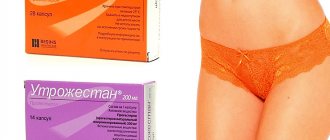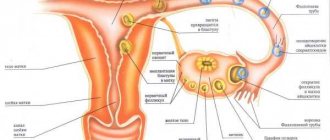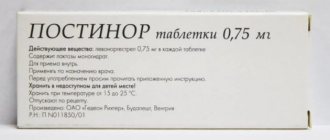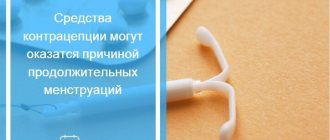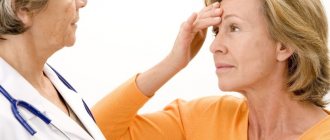As you know, women and men have different missions on our planet. Thus, the main purpose of the fair sex is to produce offspring. Sometimes couples think that there are no obstacles to pregnancy, because the woman has her periods regularly and her sexual partner is absolutely healthy. However, despite this, the much-desired pregnancy never occurs. The woman thinks that there is absolutely no reason to seek help from a gynecologist, because the time has simply not yet come for pregnancy, sooner or later this will definitely happen. The main thing is to try. But in reality the picture may be much sadder. For example, a representative of the fair sex has critical days without ovulation. This problem is very serious and can become a significant obstacle to conception.
In this article we will talk about whether menstruation can occur without ovulation, whether this is considered normal or a pathology, and we will also find out what gynecologists think about this. Please read the information provided carefully in order to protect and equip yourself as much as possible.
What is ovulation
Before answering the question of whether menstruation can occur without ovulation, it is worth understanding what this process is. Ovulation is the process of the release of a mature egg from the ovary. In this case, each menstrual cycle, as a rule, only one egg is released approximately on the fourteenth day of a twenty-eight-day cycle. In this case, the ovulation process approximately lasts about a day, and it is during this time that a woman has the greatest chance of becoming pregnant. However, quite high chances of conception also exist several days before ovulation and several days after it.
The probability of conception in the absence of menstruation
Fertilization in the absence of menstruation is quite possible. If there are no “women’s days” for 2 or more cycles, the doctor makes a diagnosis of amenorrhea.
There are only two varieties of it: true and false.
In the first case, the absence of menstruation is explained by a malfunction of the reproductive system. Eggs do not mature here, and therefore there is no point in thinking about conception. Fertilization is possible only after a course of therapy aimed at restoring the menstrual cycle.
False amenorrhea is the absence of menstrual symptoms. With it, eggs continue to develop and fertilize, although no bleeding is noticed. Conceiving a child in such a situation is not difficult, but carrying a child to term may cause problems.
https://youtu.be/I0YhgF5dbLY
How to understand that ovulation has occurred
During this period, almost all representatives of the fair sex notice that their mood improves greatly and a strong sexual desire appears. A woman’s appearance even changes: her skin condition normalizes, her eyes glow, and she simply radiates happiness. Thus, the fair sex becomes attractive to men.
During menstruation, a dead egg is released from the body, provided that fertilization has not occurred.
Lack of ovulation after menstruation - anovulation
The uniqueness of the female body manifests itself in different ways - for some, the process of ovulation occurs immediately after menstruation, while for others it does not occur even with complete confidence in the absence of the desired pregnancy. Anovulation is not such a rare diagnosis that is the cause of infertility. Factors influencing the occurrence of pathology may include:
- thyroid dysfunction;
- insufficient development of the adrenal glands;
Symptoms of the disease are very short periods, lasting no more than one or two days, and the inability to conceive. If any abnormalities are detected, you should immediately consult a doctor. Early diagnosis and adequate treatment, including, if necessary, a stimulation procedure, will help solve the problem and give the woman the joy of motherhood. It is not uncommon for the reason for the lack of ovulation to be an emotional state. Obsessive thoughts about possible infertility prevent the onset of ovulation, which, in turn, causes even more anxiety. A good rest and a course of psychotherapy are a great way to get out of a vicious circle.
Each woman has her own unique biological rhythm. This applies to both the individuality of the menstrual cycle and the regularity of ovulation. Even if you are the happy owner of an ideal cycle, you should remember that it changes after abortion and childbirth, and it will take time to restore the usual rhythm. And after forty years, a gradual decline in reproductive function begins, ovulations become more rare, and over time they completely disappear.
Most often, anovulatory periods are characteristic of young girls during puberty and restructuring of the body, as well as women during menopause. In other age categories of healthy women, the percentage of the presence of an anovulatory cycle is very low, about 1-3 percent.
Can menstruation occur without ovulation: possible physiological reasons
In fact, there are a large number of reasons why a woman does not ovulate. Scientists classify them as physiological and pathological. First, let's look at natural factors.
- Beginning of puberty. Most often, the first couple of years after the onset of puberty, a young girl cannot yet become pregnant, since the formation of the genital organs has not yet been completed. In this case, the risk of pregnancy is minimal, but it cannot be excluded.
- Physiological signs also include pregnancy and lactation. At this time, ovulation does not occur.
- It does not occur during menopause either.
Many women are interested in the question of whether they can have periods without ovulation after using hormonal contraceptives. According to gynecologists, oral contraceptives have a significant effect on a woman’s hormonal system, so ovulation may not occur for several months after stopping the use of hormonal drugs.
If ovulation does not occur a couple of times a year for natural reasons, then this is not considered a pathology. This is typical for every woman of reproductive age.
Anovulation
The phenomenon in which the follicle does not rupture and the egg is not released is called anovulation. In almost all situations, this condition is the main symptom of developing infertility. The disease has a specific cause. It could be as follows:
- Disruption of the hormonal system.
Single anovulations are within normal limits. This process can be influenced by seemingly insignificant factors. These include changing your place of residence, taking certain medications, or reducing your body size. Lack of ovulation is also typical during the breastfeeding .
Presence of pathological causes
Is it possible to have periods without ovulation? That's how it happens. And most often this happens precisely in the presence of pathological reasons. Let's consider what should be included here.
A woman has lost or gained weight very sharply. Both the first and second phenomena lead to serious disruptions in the body’s hormonal system.
Lack of ovulation can occur if a representative of the fair sex has serious problems with thyroid or adrenal hormones.
Also, in no case should one rule out malfunctions in the functioning of the brain system. Head injuries, improper blood circulation, or the presence of benign or malignant formations can lead to disruptions in the menstrual cycle.
Presence of diseases of the female genital organs. The most common of these is polycystic ovary syndrome. In the presence of such a pathology, it is very difficult for a woman to become pregnant, because not only the structural components of the female gonads will change, but also the functions that they perform.
Can women who play sports professionally have periods without ovulation? This phenomenon is quite possible, since excessive physical activity contributes to a significant decrease in the production of female sex hormones, which take an active part in the maturation of eggs.
Under no circumstances should stress conditions be ruled out. Serious problems at work, quarrels in the family, separation from a loved one and many other factors can lead to severe and prolonged depression, which has an extremely negative effect on the functioning of the female genital organs.
The presence of inflammation and infections of the internal genital organs is one of the most common reasons for the lack of ovulation.
We should also not exclude the use of medications that are directly related to disruption of the release of female hormones responsible for the ovulation process.
In very rare cases, a phenomenon called ovarian malformation is observed. It is possible to cure such a pathology, but the treatment process will be difficult and take a lot of time.
Woman's menstrual cycle
Any phenomenon of the reproductive system is carried out under the influence of hormones. The menstrual cycle consists of two phases, which are separated by ovulation. The first is called follicular. It begins with the arrival of menstruation and is characterized by the growth of follicles (10-12 pieces) in the ovaries, and eggs mature inside them.
But approximately on the third day after the end of menstruation, a dominant follicle , as a rule, there is one, but in rare situations there are several of them, which continues to grow. The rest shrink and disappear . Also during this phase, the functional layer of the endometrium increases, which is necessary for implantation of the embryo in the event of conception.
About 17 hours before ovulation, a powerful
release of the hormone LH .
Under its influence, the follicle bursts, and the egg is sent into the fallopian tube to meet the sperm. During this period, a woman has the opportunity to become pregnant. The body works hard to prepare for potential conception . This is reflected in external signs. The most obvious of them include:
Menstruation without ovulation: symptoms
Of course, you can accurately determine the presence or absence of ovulation only by seeking help from a gynecologist. However, there are a number of signs by which you can make a diagnosis yourself. Let's look at the main symptoms of menstruation without ovulation.
The occurrence of excessive acne, obesity, as well as excessive growth of facial hair according to the male type - such signs are the main evidence that a woman does not ovulate due to polycystic ovary syndrome or serious problems with the adrenal glands.
The occurrence of mastopathy. This pathology occurs due to the fact that a woman’s production of female sex hormones is disrupted.
Is it possible to have periods without ovulation? Any gynecologist will tell you that they are possible, and this phenomenon is very common.
Lack of ovulation may be indicated by very long periods. Sometimes uterine bleeding is observed, which a representative of the fair sex may mistake for menstruation.
And, of course, the couple has serious problems with the ability to conceive a child. In the absence of the ovulation process, this is simply impossible.
How to most accurately calculate the days of ovulation after menstruation
There is some disagreement about how to determine the most successful days for successful conception. Some consider the calendar method to be error-free, others prefer to trust the readings of basal temperature, and still others tend to rely only on the results of special tests or ultrasound. To choose the most suitable method for determining the days of ovulation after menstruation, let's take a brief look at each of them.
In the classic version, with a perfectly regular cycle, calculating the days of ovulation after menstruation is not so difficult, although the reliability and appropriateness of the results can be argued. For most women, the cycle length is in the range of 28 - 34 days, ovulation occurs approximately two weeks before the arrival of the next menstruation. If we take the duration of 28 days as a basis and subtract 14 from it, the desired result will be 14. This number shows how many days after ovulation after menstruation will allow a new life to be born.
To create your own calendar of days that are safe and, conversely, favorable for the expected conception, you first need to get used to marking the date of your period. By calculating the difference between them, it is easy to determine the duration of the menstrual cycle and at the same time pay attention to its regularity. Then you need to subtract 14 from the resulting number, the result will tell you how many days you should expect ovulation after the start of your period. Let's look at an example: the menstrual cycle lasts 31 days, subtracting 14 from this number we get 17, which means that ovulation will occur approximately on the seventeenth day of the cycle.
Why "approximately"? Because it is not at all a fact that you ovulate 14 days before your period. And if this happened last month, then this month she is quite capable of being late or pleasing with her appearance a little later. In addition, it is very doubtful that the duration of the cycle from month to month is exactly 31 days. Experts note that it is quite rare for beautiful ladies to have a perfectly regular monthly cycle, and the onset of ovulation depends on many factors - emotional state, hormone levels, physical activity. Therefore, using this method to determine the date of ovulation and what day after menstruation it will fall is very approximate.
2. Basal temperature signals ovulation
A fairly popular and reliable method for determining the days of ovulation after menstruation is based on changes in basal, or rectal, temperature in different phases of the cycle. By following certain measurement rules and recording daily thermometer readings over three to four cycles, it is possible to determine how many days after your period ovulation occurs. The graph clearly shows how, approximately in the middle of the cycle, the temperature suddenly jumps by half a degree, overcomes 37°C and remains at this level almost until the arrival of the “critical” days. This jump signals ovulation.
Compared to the calendar method, the above method of determining the day of ovulation after menstruation is more informative and individual, and the combination of both will provide an even more accurate picture. Some of its disadvantages are that the graph shows ovulation that has already ended, which significantly reduces the time period for successful conception. However, with its help, continuing measurements, you can predict the upcoming timing of ovulation, based on previous indicators. It will also be easy to determine how long after ovulation your period comes, and it will never take you by surprise. This indicator is usually stable.
3. Determination of ovulation - as quickly and reliably as possible
For those who find the first two methods for determining ovulation after menstruation too troublesome, special tests are sold at the pharmacy. With their help, calculating the period of ovulation is extremely simple - at the moment of the largest release of progesterone, the strip turns a rich color and reports the release of a cell prepared for fertilization. It is impossible not to notice that determining the days of ovulation after menstruation using a test is not a cheap pleasure. Therefore, it is most rational, after all, to use this method after preliminary determination of the upcoming calendar method. If, according to your calculations, you know approximately how many days ovulation will occur after menstruation, it will be much easier to “catch” it with the help of magic strips.
For example, the duration of your menstrual cycle is 29 days. Taking into account how long after ovulation menstruation is possible (12-16 days), we subtract 17 from this number. This means that the use of test strips is appropriate starting from the twelfth day of the cycle. The number 17 is used for any length of the cycle. If it is 32 days, then 32-17=15 - we start using the test no earlier than the fifteenth day. Sometimes the ultrasound method is used, which accurately records the maturation of the follicle and the moment the egg is released. If the menstrual cycles are not regular, when calculating, we use the shortest of them and subtract the treasured number 17 from it.
4. Determining ovulation after menstruation based on how you feel
Some women, observing themselves and their loved ones, are able to accurately identify external harbingers of ovulation. These include:
- quite noticeable pain in the lower abdomen, which can occur for a few minutes, or can be annoying for several hours;
- soreness and hypersensitivity of the breast;
- viscous discharge reminiscent of chicken protein;
- evidence of hormonal imbalance - tearfulness, irritability, mood swings;
- increased sexual desire;
- change in taste sensations.
However, it is not uncommon for there to be a complete absence of signs that ovulation is already on the way, although enough time has passed since the period.
Thus, using one method or another, you can almost accurately find out when you should ovulate, on what day after your period the egg will be released, ready for the fateful meeting with the sperm. It is absolutely obvious that the two-week period called by many is too average; many women can ovulate immediately after menstruation. Judge for yourself - if the cycle is too short, for example, 22 days, and menstrual flow bothers you for 6-7 days, then, considering how long after ovulation your periods begin, you can expect the release of the egg literally immediately after the end of the “critical” days.
Ovulation test
There is a special test to determine the presence of ovulation. It can also be done at home. This test takes the form of paper strips on which a special reagent is applied that can react to the presence of luteinizing hormone in the urine. If its amount in the urine is increased, this indicates that ovulation is currently occurring in your body. In order to conduct such a test, you need to lower the strip into a container with urine or place it under a stream of urine.
Should I see a doctor and when?
When there is no ovulation, but you have your period and it lasts more than three months, you need to see a doctor as soon as possible. In this case, there is a high probability of developing pathology.
For treatment, the doctor usually prescribes gestagens. They help eliminate the symptoms of anovulation and bring the cycle back to normal. If these remedies do not work and menstruation does not occur, there is a high probability of infertility - then you will have to take drastic measures and contact a surgeon or go to the hospital under constant medical supervision.
Practicing treatment at home using traditional methods found on the Internet or “on the advice of your grandmother” is strictly prohibited.
You are allowed to contact them only after consulting a doctor. Otherwise, you can only worsen your condition and reach infertility, while simultaneously developing several new ailments.
Author: Rebenok.online · Published 04/25/2017 · Updated 02/14/2019
Many processes occurring
in a woman’s body are closely related to each other. Medicine has long proven that such a connection can be traced between menstruation and ovulation. But not in all episodes the lack of ovulation affects the arrival of menstruation. This is what makes it difficult to notice a deviation in the reproductive system in time.
When to do this test
In order for this test to show the most accurate results, you need to calculate the length of your cycle, namely the number of days from the first day of your period to the first day of your next period. Doctors recommend doing the test daily from the eleventh day of the cycle. This way you can determine what day, if any, you ovulate.
To carry out the test, do not take morning urine, as it will contain a small amount of the necessary hormone. Take the test at the same time of day every day. The use of this test is not much different from a similar test to determine pregnancy. Pay attention to the stripes. It may take you about thirty minutes to find out the exact result. Therefore, you should not expect that you will know the results within the first minute.
If you see two stripes, this indicates that ovulation will occur within twenty-four to forty-two hours. One strip indicates that the result is negative. This means the test needs to be done the next day.
The menstrual cycle, ovulation and conception - learning the basics
The unique and rather complex human reproductive system is carefully thought out by Mother Nature to the smallest detail, admiring its foresight and clear focus on procreation. Already at birth, a female baby receives a sufficient supply of eggs - about a million. For the time being, they will calmly wait for their time. When you reach the age when pregnancy becomes possible, cyclical menstruation “delights” with its appearance. It is generally accepted that the beginning of the cycle, the duration of which is variable and strictly individual, is the day of the appearance of full-fledged, non-smearing discharge.
Every month, from the supply of eggs given at birth, one of them matures and comes out, ready for the desired fertilization. The time period of its appearance is called ovulation. She only has 24 hours to have a successful date with the sperm. If the meeting this time is not destined, she will die and conception will not take place. The place prepared for it in the mucous layer of the uterus, as unnecessary, will be rejected and come out during menstruation. That is why, when planning the birth of a baby, it is so important to take into account exactly when ovulation occurs after menstruation, and to ensure an effective meeting of the sperm and the mature egg for effective conception. This issue is no less of concern to those who intend to refrain from expanding their family composition for the time being. Having information about the date of ovulation, you can limit intimate encounters during this period or take the choice of contraceptives more seriously.
Features of treatment
We have already answered the question whether menstruation is possible without ovulation. Now it’s time to figure out how to treat this phenomenon. Before prescribing treatment, it is very important to accurately determine the cause of the disease. Please note that you cannot do this on your own, so be sure to consult a gynecologist. In some cases, a woman, in order to restore her menstrual cycle, simply needs to reconsider her diet and lifestyle. If a representative of the fairer sex is obese, then even a slight weight loss can lead to positive changes.
Many women worry about having a cycle without ovulation. When should I expect my period in this case? The body of each representative of the fair sex is individual. For some they will arrive on time, for others with glitches. The main thing is not to delay your visit to the doctor and start treatment in a timely manner. If the problem lies in the functioning of the thyroid gland, the patient will be prescribed special hormonal medications.
If the level of prolactin in the body is excessively elevated, then it is very important to prescribe medications that will help reduce it.
Treatment
Under no circumstances should you self-medicate. Only a qualified specialist can
restore ovulation In each individual situation, a certain dose of hormones is selected. Most often, the drugs are tablets. One of the popular ones is Proginova. Sometimes injections are prescribed. Additionally, it is recommended to use vitamin therapy .
There are also traditional methods for treating anovulation. They represent various herbal preparations. It is not recommended to take decoctions based on them without a doctor’s prescription. Herbal ingredients are not as harmless as they might seem at first glance. Some of them contain large doses of phytohormones , tannins and flavonoids. During treatment, it is important to adhere to a certain dosage.
Anovulation is equated to infertility. Despite this, it can be successfully adjusted. A large number of women with this diagnosis have repeatedly become mothers of healthy babies. To do this, it is enough to identify the deviation in time and follow the recommendations of specialists .
Use of medications
In this article, we answered the question of whether menstruation can occur without ovulation. If it is impossible to influence the cause that caused this phenomenon, then it is necessary to take medications that will artificially stimulate the ovulation process.
Let's look at the most commonly prescribed medications by gynecologists:
- "Menogon" is a very effective drug, it causes an increase in the level of estrogen in the blood, and stimulates the maturation of the egg.
- Duphaston is also a very effective remedy, widely used against infertility and lack of ovulation. The main advantage of this product is the complete absence of androgenic side effects.
- "Utrozhestan". It is recommended by doctors as an effective medicine containing natural progesterone.
Please note that all of the medications listed can only be taken on the strict recommendation of a doctor. Otherwise, they can cause irreparable harm to your health.
Conception did not occur - how long after ovulation do menstruation occur?
It is often mistakenly assumed that the ovulation process lasts from three to five days, which are considered the most favorable for conception. In fact, this process takes several minutes, and then, within 24 hours, the egg impatiently awaits a meeting with a sperm ready to fertilize it. He can already wait for this opportunity for 3-4 days without losing activity, or he can get caught during sexual intercourse that happened within 24 hours. If the date does not take place, the egg dies, and the body prepares to reject it along with the unnecessary thickened layer of the uterine mucosa. Want to know how long after ovulation your period comes? After about 12-16 days, the indicator is individual. With a regular cycle lasting 28 days, discharge most often appears 14 days after ovulation. In case of successful conception, a comfortable bed of the uterine mucosa will be needed for the development of the egg, which most often occurs approximately seven days after successful fertilization. The question of how long after ovulation menstruation is inappropriate and not relevant - there will be no menstruation.
Causes of anovulation
The female monthly cycle develops under the guidance of complex immune and endocrine, neuropsychic and cardiovascular processes, therefore the factors leading to the absence of ovulation can be caused not only by abnormalities in the patient’s reproductive system and her genital structures. Anovulation is considered absolutely natural in menopausal patients, when the appendages stop functioning, and in adolescents, when ovarian function is just beginning to function fully.
Experts divide the factors for the development of anovulation into pathological and physiological. Pathological causes usually always cause a chronic absence of ovulatory processes and are caused by the development of some disease. And physiological factors are associated with natural events inside or outside the female body.
Physiological factors
The category of anovulatory causes of a physiological nature includes many factors.
- Pregnancy and breastfeeding, menopause and just completed puberty, prior to childbirth. During pregnancy, hormonal ovarian activity changes dramatically, and after delivery it is gradually restored. But women in labor recover their periods faster than ovulation. In addition, for normal lactation, the body actively produces prolactin, which can not only inhibit ovulatory processes, but also menstrual bleeding (while the mother is breastfeeding the baby). According to statistics, in half of women in labor, renewed cycles are anovulatory, single-phase.
Weight deficiency. The origin of such a factor does not matter, if the female body experiences malnutrition, then a deficiency of useful elements such as fats, vitamins, proteins, microelements and carbohydrates develops. A woman needs subcutaneous fat, because it is the fat that secretes estrogen hormones and also takes part in thermoregulatory and metabolic processes. If you are underweight, your periods may stop altogether.
- Prolonged emotional overstrain and stressful situations are also often physiological factors of anovulation. Psycho-emotional stress provokes cerebral spasms, which causes nutritional disturbances of the hypothalamic-pituitary apparatus. The body is looking for ways to protect against stress, so it begins to actively produce bioactive components that inhibit ovulatory processes. Some experts are inclined to believe that the maturation of the egg stops due to a protective reaction; it is simply the way the female body protects itself from pregnancy under unfavorable conditions.
Even intense physical activity or climate change, long travel and overwork can provoke disturbances in ovulatory processes. The absence of ovulation in patients taking contraceptive drugs is considered normal, since they suppress the processes of egg maturation. With long-term use of oral contraception, many girls experience a characteristic complication; after stopping these drugs, they live for another six months without menstruation and ovulation, unable to get pregnant.
I didn't ovulate, will I get my period?
With a condition such as anovulation, there is usually an absolute absence of menstruation (amenorrhea) or scanty discharge (oligomenorrhea) lasting 2-48 hours. Long delays, followed by scant bleeding, are also likely. For some girls, their periods come as before, so they don’t notice any changes, which seriously complicates identifying the problem. In such situations, it is possible to establish the absence of ovulation only when planning conception, when the woman tries in vain to become pregnant.
The presence of menstrual bleeding depends on the thickness of the endometrial uterine layer. It is to this that the female cell is attached upon fertilization. If conception does not occur, the endometrial layer is rejected and leaves the uterus in the form of menstruation. The thickness of this layer is regulated by the hormone estradiol, with a deficiency of which the endometrium does not grow to the required size. As a result, periods become suspiciously scanty or absent altogether. It is considered quite normal if a woman has anovulatory cycles a couple of times a year.
Anovulatory cycle
But it also happens that the onset of menstruation occurs, but there is no ovulation. In fact, the egg does not mature and is not released from the ovary in such cycles, which are also called anovulatory. Moreover, every month the patient’s periods come on time, i.e. their regularity and abundance do not change. Typically, anovulatory cycles are a consequence of hormonal dysfunction, which is characterized by the loss of physiological rhythm in the female cycle due to the absence of the ovulatory period. It’s sad, but in most cases, infertility in girls occurs precisely against the background of a lack of ovulation. But it cannot be said that the lack of ovulation is associated specifically with pathology.
The monthly cycle is formed by hormonal processes occurring in the ovaries, which mature along with the woman. When puberty occurs, the ovaries begin secretory activity, which ensures the maturation of eggs. Inside, the ovary is filled with small follicles containing an egg, which mature sequentially. During one menstrual cycle, only one (at most 2) egg has time to mature, although at the same time there are many cells in the ovary that are at different phases of maturity.
When the cell finally completes development, it loses the need for nutrition, so it destroys the wall and leaves the ovary to fulfill its purpose - to meet with sperm, be fertilized and form into an embryo, and then into a fetus. The period when a female cell is released is called ovulation. After release, the egg remains viable for one and a half to two days.
